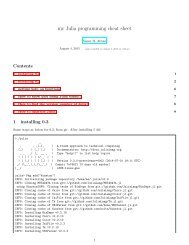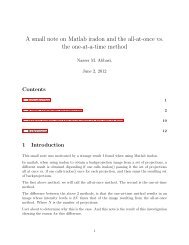You also want an ePaper? Increase the reach of your titles
YUMPU automatically turns print PDFs into web optimized ePapers that Google loves.
Now that µ 1 , µ 2 are found, the mass normalized eigen vectors are found. They are called Φ 1 , Φ 2<br />
⎧ ⎧ ⎫<br />
⎨ ⎨ 1 ⎬<br />
Φ 1 = ϕ 1<br />
√<br />
µ1<br />
=<br />
⎩<br />
ϕ 11<br />
⎧ ⎫<br />
⎨ 0.925 ⎬<br />
=<br />
⎩<br />
−0.219<br />
⎭<br />
ϕ 21<br />
⎫<br />
⎬<br />
⎭<br />
√<br />
µ1<br />
=<br />
⎩<br />
−0.237<br />
⎭<br />
√<br />
1.169<br />
Similarly<br />
Φ 2 = ϕ 2<br />
√<br />
µ2<br />
=<br />
⎧<br />
⎨<br />
⎩<br />
⎧ ⎫<br />
⎨0.380⎬<br />
=<br />
⎩<br />
0.534<br />
⎭<br />
ϕ 12<br />
ϕ 22<br />
⎫<br />
⎬<br />
⎭<br />
√<br />
µ2<br />
=<br />
⎧<br />
⎨<br />
1<br />
⎫<br />
⎬<br />
⎩<br />
1.404<br />
⎭<br />
√<br />
6.914<br />
Therefore, the modal transformation matrix is<br />
[Φ] = [Φ 1 Φ 2 ]<br />
⎡<br />
⎤<br />
0.925<br />
= ⎣<br />
0.380<br />
⎦<br />
−0.219 0.534<br />
This result can be verified using Matlab’s eig function as follows<br />
EDU>> K=[3 -2;-2 2]; M=[1 0;0 3];<br />
EDU>> [phi,lam]=eig(K,M)<br />
phi =<br />
-0.3803 -0.9249<br />
-0.5340 0.2196<br />
EDU>> diag(sqrt(lam))<br />
0.4380<br />
1.8641<br />
Matlab result agrees with the result obtained above. The sign difference is not important. Now step 5 is<br />
applied. Matlab generates mass normalized eigenvectors by default.<br />
Now that [Φ] is found, the transformation from the normal coordinates {x} to modal coordinates, called<br />
{η} , is obtained<br />
{x} = [Φ] {η}<br />
⎧ ⎫ ⎡<br />
⎤ ⎧ ⎫<br />
⎨x 1 (t) ⎬<br />
⎩<br />
x 2 (t)<br />
⎭ = 0.925 0.380 ⎨η ⎣ ⎦ 1 (t) ⎬<br />
−0.219 0.534<br />
⎩<br />
η 2 (t)<br />
⎭<br />
12





